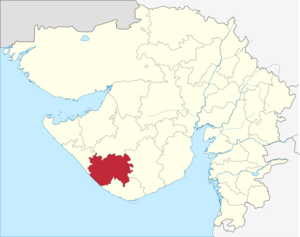Junagadh (District)
| Junagadh District | |
|---|---|

|
|
| State | Gujarat |
| Administrative headquarters : | Junagadh |
| Area : | 8,831 km² |
| Residents : | 2,743,082 (2011) |
| Population density : | 311 inhabitants / km² |
| Website : | [1] District website |
The Junagadh district (formerly also Junagarh; Gujarati : જુનાગઢ જિલ્લો ) is one of 26 districts of the Gujarat state in India . The city of the same name Junagadh is the capital of the district. The last census in 2011 showed a total population of 2,743,082 people.
history
From pre-Christian times until 1472 the area - like the whole region - was ruled by various Buddhist and Hindu rulers. The first civilization was the Indus culture . The area was ruled by the Rajputs in the Middle Ages and was involved in constant battles with Muslim armies. The last non-Muslim dynasty were the Rajputs of Chudasama. After centuries of military conflicts with Muslim conquerors and rulers in northern India, it was occupied by Muslim soldiers in 1472. After that, various Muslim dynasties ( Sultanate of Delhi , Sultanate of Gujarat and the Mughals ) ruled until 1735 . In 1735 the Afghan Sher Khan Babi founded a principality independent of the Mughals. This Junagadh State remained an independent princely state until 1807 , despite constant fighting with the Marathas. In that year Junagarh State became a British protectorate. From 1818 to 1947 it belonged as an independent prince state to the Sorat Prant within the Kathiawar Agency and thus administratively to the British administrative region of Bombay Presidency . With the independence of India in 1947, the Kathiawar Agency became Saurashtra (state) . Since the Nawab Muhammad Mahabat Khan III was a Muslim, he decided to join Pakistan. On September 13, 1947, Pakistan accepted the annexation of the prince's state despite the lack of land connection. However, since around 80% of the population were Hindus, there was unrest over this political decision. Various areas within Junagadh State have declared their loyalty to India. After the pressure from India increased, the Nawab and his family left the area and fled by plane to Karachi in Pakistan. The Indian army invaded and on November 9, 1947 an Indian governor was installed. He arranged a referendum on February 20, 1948 on the whereabouts of the area. Of the more than 200,000 voters, around 91% were in favor of India and only 9% in favor of Pakistan. On January 20, 1949, Junagadh therefore became part of the state of Saurashtra . The Junagadh / Junagarh district only became part of the Bombay state again with the dissolution of the Saurashtra state in 1956 . In 1960 this Indian state was divided and the area came to the newly created state of Gujarat.
population
Population development
As everywhere in India, the population in the Junagadh district has been growing rapidly for decades. The increase slowed, however, in the years 2001–2011 to around 12 percent (12.05%). In these ten years, however, the population increased by almost 300,000 people. The following table shows the exact numbers:

Significant places
The most populous town in the district is the capital Junagadh with over 300,000 residents. Other major cities with a population of more than 20,000 people are Veraval , Keshod , Mangrol , Una , Kodinar , Manavadar, Sutrapada, Chorvad and Talala. The urban population makes up 33.04 percent of the total population.

Web links
- Junagadh district map
- Junagadh District
- Economy, nature and sights
- 2001 census result for Junagadh
- Junagadh District Statistical Manual
Individual evidence
- ↑ 2011 census
- ^ History of the district up to 1900 in the Imperial Gazeteer Of India
- ^ Result of the 2011 census on city population
Coordinates: 21 ° 31 ' N , 70 ° 27' E

